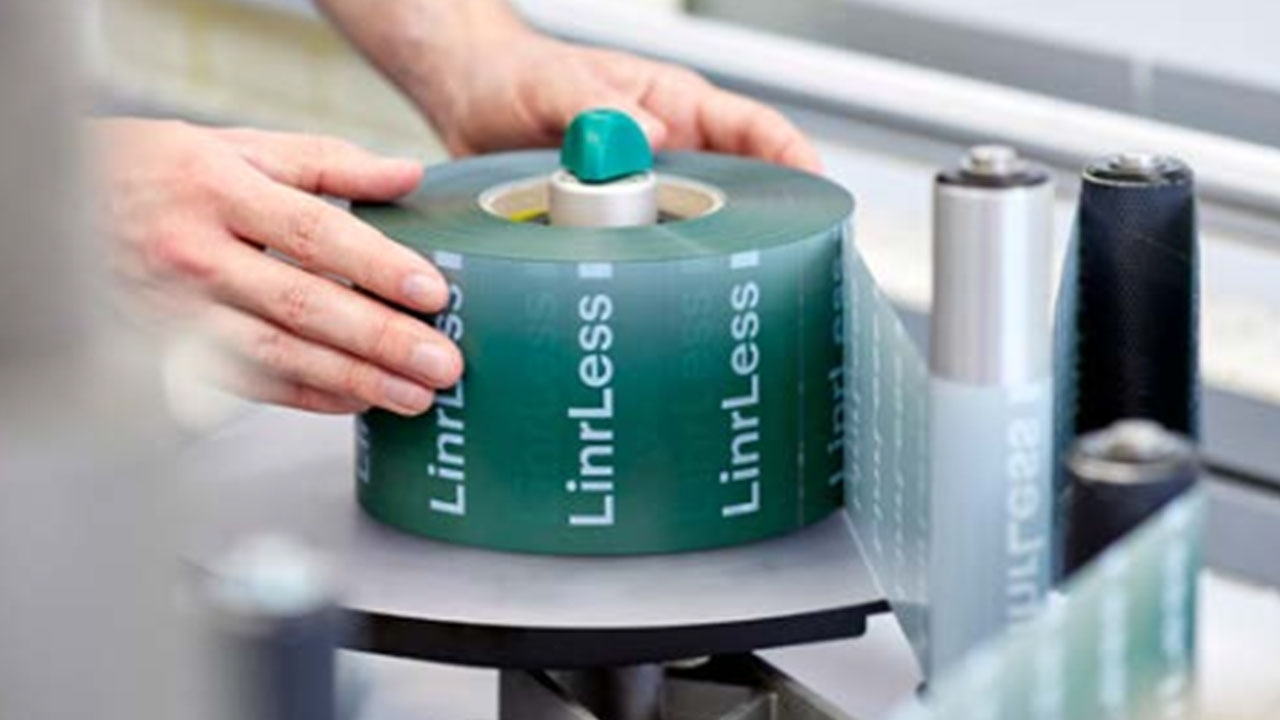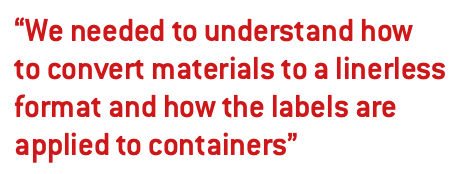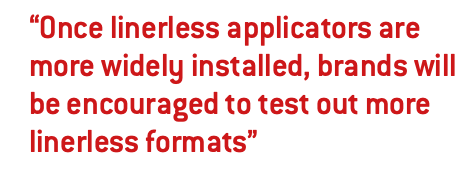Avery Dennison launches decorative linerless system
With its AD LinrSave technology, Avery Dennison is looking to transform the market for linerless prime labels.

Avery Dennison launched at Labelexpo Europe 2023 a new decorative linerless technology, as the first step in a bid to transform the pressure‐sensitive prime label market.
In March last year, Avery Dennison acquired the IP of a linerless label technology developed by Catchpoint, a UK company based in Yorkshire, England, and its pioneering champion Mike Cooper. At the same time, Wayne Middleton joined Avery Dennison from Catchpoint, having previously spent many years at Innovia Films, with the express task of commercializing the Catchpoint technology.
‘Mike Cooper supported us greatly as a consultant, helping us gain the right knowledge and sharing his experience with Avery Dennison’s team,’ Middleton says.
While direct thermal linerless has been around for a long time, showing huge growth in simple applications like e‐commerce, quick service restaurants and price‐weigh labels, linerless labels have not made a significant impact in the decorative labeling sector – although Ravenwood has shown some good advancement of linerless technology in the food tray market sector.

‘The question for Avery Dennison became, with sustainability being at the core of everything we do, how can we help create a linerless future?,’ recalls Middleton. ‘We’re committed to delivering innovations that advance the circular economy: from lowering carbon footprint to making a positive social impact. Therefore, through the acquisition of Catchpoint’s IP, Avery Dennison could move forward with our own internal developments at higher speed. We could really hit the ground running and take the technology forward. After I joined in March 2022, we spent 14 months operating off the radar.’
Continues Middleton: ‘We needed to understand how to convert materials to a linerless format and how the labels are applied to containers. We explored different materials, different sizes and shapes of labels and different adhesive and release systems.’
Converter partners
The next step was to select converter partners and get them up to speed. ‘We were looking for converters who were sustainability‐ minded and had the capability and the innovation mindset,’ says Middleton. ‘We started putting pilot projects together around Europe to understand how to convert and handle open adhesives and the micro‐perforations Mike’s technology required. Today those converters are making their first rolls of self‐wound decorative linerless labels.’
For label converters, one of the key advantages of the Catchpoint system is that it does not require a major investment in specialist converting equipment.
‘We are trying to use converters’ existing equipment base, which really helps to get them on board, and we put the rest of the ecosystem in place around them,’ explains Middleton. ‘So, the release coating can be applied on a standard flexo printing unit and converters can use their existing die stations. We trained the die manufacturers how to get the correct micro‐perforation into their mag plates.’
The micro‐perforations are in many ways the key to the success of the whole system. ‘This is really what the whole Catchpoint technology revolves around,’ explains Middleton. ‘We are not trying to separate the whole height of the label at once on the applicator. The slits break the perforations into smaller zones. The profile on the applicator tool engages with the slits and helps to “unzip” the perforations, which means you can be more consistent and faster in applying the labels to the container.’
Working with Bobst
Selection of the UV release coating presented a challenge, says Middleton. ‘Most UV release coatings require a nitrogen inertion unit and only a few converters have that. So we needed to select a release system that did not require nitrogen inerting. Another issue was the release coating tended to sink into the open surface of paper labels. So now we apply a primer first on paper, then a release coating, so this takes two flexo stations on the press. Film has a closed surface that does not need a primer.’

Avery Dennison worked closely with Bobst to trial the application of the UV release coating. ‘We proved that on a Bobst M5 press, it is feasible to convert linerless label materials in‐line in one process. On the release coating station, you need the correct coat weight to achieve 100 percent coverage and you have to make sure you are fully curing, as migrating release coating can interfere with the adhesive.’
The linerless labels can also be converted off‐line. ‘There is a debate here ‐ do you finish in‐line, on press, or on off‐line finishing equipment?’ says Middleton. ‘We have done both. We can also print digitally and finish off‐line. With a digital combination press, all these techniques are feasible.’
Applicator trials
The Catchpoint technology requires a dedicated linerless applicator, either a linear conveyor‐belt applicator or a high‐speed rotary platform. A previously developed adapter, which turns a standard linear applicator into a linerless applicator without requiring additional electronics, has been further refined by Avery Dennison on its in‐house pilot line.
Avery Dennison selected Novexx as its specialist partner to scale up the installation of the adapters onto linear applicators. Novexx and its distributors will be responsible for on‐site modifications to users’ labeling lines. Novexx was formerly Avery Dennison’s in‐house applicator division before it was spun off.
For rotary applicators, Avery Dennison partnered with Italian company Ilti, which developed rotary linerless heads for both its own and third‐party rotary applicators.
Addressing brand issues
Looking at the potential end uses for AD LinrSave, Middleton points to a wide cross‐section of market segments from wine and spirits to beverages and personal and home care. But how will AD LinrSave deal with brands’ historic reluctance to adopt decorative linerless technology?
One major obstacle for many brands is the shape limitation: linerless labels must be either square or rectangular. But Middleton says the sustainability benefits will rapidly outweigh reservations on shape.
‘We not only eliminate liner waste from the brand’s labeling operations, but with square or rectangular labels joined together by perforations and slit side by side during conversion, we also eliminate matrix waste both in the machine and cross directions.’

It is, in fact, possible to die‐cut a curved top to the label, but again this introduces matrix waste. ‘So, what is the brand’s real driver? We estimate that 75‐80 percent of labels are rectangular or square anyway, so this could be something brands would be prepared to live with to gain the sustainability benefits. And with a clear film the graphic design can give a convincing illusion of shape without the need to die cut.’
A key brand concern has been visible perforations left after the linerless labels have been separated. ‘Some people thought we were producing postage stamps!’ laughs Middleton. ‘But using the latest technology you cannot see the perforations – you can run your finger down the edge and feel it but visually you can’t see the perforations.’
Another major stumbling block has been brands’ reluctance to disrupt their existing high‐volume automated PS labeling lines. Middleton argues that for some brands it would be ‘relatively straightforward’ to introduce linerless if there was a modular system that you can simply roll in and out.
‘The back label is also a good starting point. As these tend to be rectangular, a brand could run only its back labels in linerless format and start to standardize that across their product range.’
Future innovation
Avery Dennison sees the launch of AD LinrSave as the first step on a journey to make linerless a mainstream decorative PS technology.
Middleton firmly believes that the increased take‐up of decorative linerless labels will spark a new wave of innovation.
‘It will open peoples’ eyes to how to convert labels in a different format. For example, because the liner no longer has to deliver the label to the container, the performance requirements of the liner can be adapted. You might look at a different liner to glassine, for example, which is more difficult to recycle, or a more optimized release coating formulation.’
Middleton says the next generation of PS label applicators will be designed from the ground up for ease of conversion to linerless. ‘Conventional PS labels will not disappear, so the ability to run in dual mode will be key. We might also see the development of late‐stage die cutting for shapes, but again that re‐introduces waste.’
Middleton compares the current situation with linerless to the push‐pull cycle of the electric vehicle market. ‘You need a network of chargers before people feel they can move to electric vehicles, and then adoption rapidly ramps up. Similarly, once linerless applicators are more widely installed, brands will be encouraged to test out more linerless formats.’
The approach of sustainability targets will also drive linerless adoption. ‘Over the last couple of years, we had the pandemic and then supply chain shortages, and now businesses are returning to normal we are only a few years away from 2030 sustainability targets. So now they are focused on achieving those targets, and linerless has an obvious contribution to make.’
Stay up to date
Subscribe to the free Label News newsletter and receive the latest content every week. We'll never share your email address.


